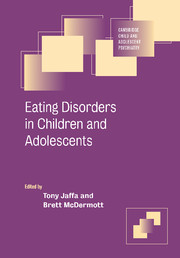Book contents
- Frontmatter
- Contents
- List of Contributors
- Part I Introduction
- Part II Scientific underpinnings
- Part III Abnormal states
- 9 Anorexia nervosa in children and adolescents
- 10 Eating disorders in boys
- 11 Bingeing and bulimia nervosa in children and adolescents
- 12 Selective eating and other atypical eating problems
- 13 Comorbid anxiety and depression and the role of trauma in children and adolescents with eating disorders
- 14 Eating disorders in children with disabilities and chronic illness
- 15 Childhood obesity
- Part IV Evidence-based care
- Part V Public health perspectives
- Index
- References
14 - Eating disorders in children with disabilities and chronic illness
from Part III - Abnormal states
Published online by Cambridge University Press: 02 December 2009
- Frontmatter
- Contents
- List of Contributors
- Part I Introduction
- Part II Scientific underpinnings
- Part III Abnormal states
- 9 Anorexia nervosa in children and adolescents
- 10 Eating disorders in boys
- 11 Bingeing and bulimia nervosa in children and adolescents
- 12 Selective eating and other atypical eating problems
- 13 Comorbid anxiety and depression and the role of trauma in children and adolescents with eating disorders
- 14 Eating disorders in children with disabilities and chronic illness
- 15 Childhood obesity
- Part IV Evidence-based care
- Part V Public health perspectives
- Index
- References
Summary
Eating, nutrition and growth
Good health demands good nutrition and in the child it is reflected in normal growth. Children who cannot or do not eat properly often become unwell and do not grow. This becomes a source of great concern and anxiety for their parents. Several chronic illnesses in children impair normal feeding; this chapter aims to describe the interrelationship between eating and disease in children with reference to some common conditions. The effects of childhood eating disorders on parents and families will also be considered.
The physiology of feeding
Understanding feeding problems in children rests on detailed knowledge of oral-motor function, the neurophysiology of feeding and child development and behaviour. The development of oral-motor skills reflects general neurological maturation and requires the coordination of the movement of at least 31 pairs of striated muscles in the mouth, pharynx and oesophagus by 5 cranial nerves, the brainstem and the cerebral cortex (Bosma, 1986). The control centre for swallowing, the nucleus tractus solitarius and the adjacent ventral medial reticular formation around the nucleus ambiguous, receive input from rostral brainstem centres, cerebellum, basal ganglia and higher cortical centres.
The swallowing process occurs in four phases: oral preparatory, oral, pharyngeal and oesophageal. The first two phases are under voluntary control, with the pharyngeal phase partly voluntary, and mostly involuntary, whilst the oesophageal phase is entirely involuntary.
- Type
- Chapter
- Information
- Eating Disorders in Children and Adolescents , pp. 169 - 181Publisher: Cambridge University PressPrint publication year: 2006

